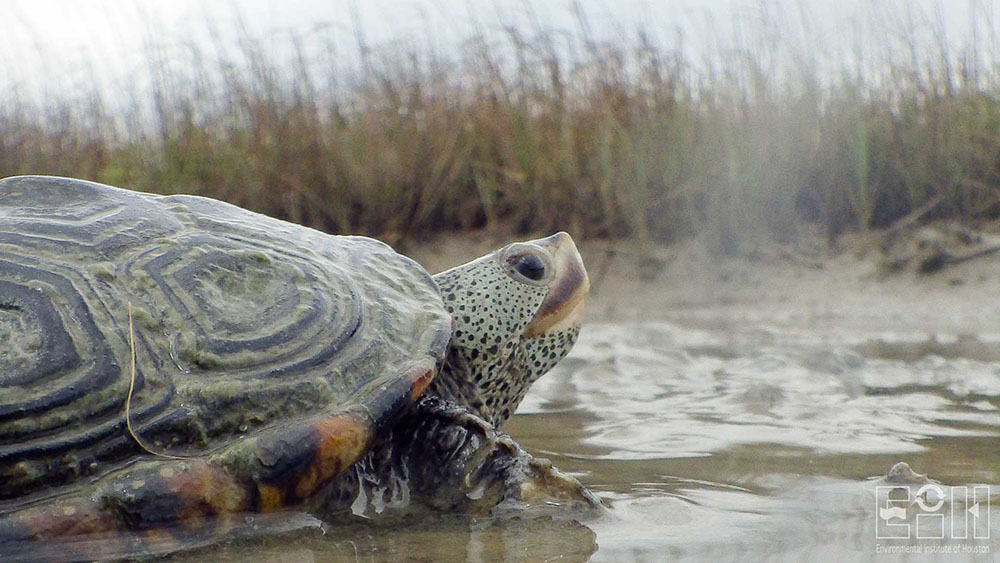
Microplastic Distribution and Impacts to Diamond-backed Terrapin, Highlighting Public Education and Future Effects of Sea-Level Rise
Purpose/Objectives
Our primary goal is to evaluate and disseminate data related to dispersion and future effects of microplastic contaminants within shoreline habitats.
Our objectives are to:
- Compile spatial data related to dispersion, sedimentation, and accumulation of microplastics;
- Investigate the implications of sea level rise on coastal habitats and evaluate its effect on current and future roles of shoreline habitats in filtering microplastics;
- Expand Nurdle Patrol survey protocols to areas otherwise inaccessible by the public and apply newly developed standardized protocols for microplastic sampling in shoreline sediments;
- Evaluate the relationship between dispersion, habitat use, and bioaccumulation of microplastic contaminants in a sentinel wildlife species; and
- Provide educational opportunities for residents in order to raise awareness of microplastic contaminants and their potential impacts to shoreline habitats.
Study Area
Matagorda and San Antonio Bays
Project Period
2023 – 2026
Description
Globally, inshore and nearshore coastal areas face a range of issues with accumulation of marine debris as a rising concern. Debris accumulation not only affects wildlife, but the people who work, live, and recreate in these areas. Accumulation and effects of microplastics (plastic particles < 5 mm in diameter) in shoreline habitats is not well understood. Microplastics may be produced from natural wear on larger plastic debris or through the release of virgin plastic particles (“nurdles”).
Coastal areas are particularly vulnerable to sea level fluctuations due to their decreased topography. These fluctuations may affect the way that microplastics are distributed throughout shoreline areas. Major climatic events or future sea level increases may detrimentally affect shorelines, including loss of habitat, destruction of wetlands serving as primary filtration areas for terrestrial run-off, and negative impacts to socio-economic factors.
Plastic bioaccumulation has been documented across a range of vertebrates, including humans. Use of sentinel wildlife species can aid in understanding potential impacts of microplastic accumulation. Diamond-backed terrapins (Malaclemys terrapin, “terrapin”) are semi-aquatic estuarine-dwelling turtles. Terrapins are an ideal candidate sentinel species in evaluating microplastics bioaccumulation as they reside in low-lying wetlands that serve as primary filtration areas for microplastics.
An important component of disseminating scientific research involves public education and outreach. Sharing information across a range of individuals leads to increased participation and interest by citizens, recreational enthusiasts, students, and educators, ultimately leading to more informed future generations. By discussing range of environmental and conservation-based topics, students and teachers are able to expand their capabilities.
The current project aims to fill knowledge gaps related to current and future shoreline habitat alteration through a multi-faceted, interdisciplinary approach. Data resulting from this study will be made publicly available through multiple sources and may be used by students, educators, and professionals for future assessments of shoreline degradation in Matagorda and San Antonio Bays.
Publications and Presentations
Gordon, M., Mokrech, M., Reistle, W., McDermid, R., Hammerbach, G., DeChellis, D., and Thurman, L. 2024. Microplastic distribution and impacts to diamond-backed terrapin, highlighting public education and future effects of sea-level rise. Quarterly Progress Report FY24, Quarter 4. EIH Report 25-001, 8 pp.
Gordon, M., Mokrech, M., Reistle, W., Oakley, J.W., McDermid, R., Hammerbach, G., DeChellis, D., and Thurman, L. 2024. Microplastic distribution and impacts to diamond-backed terrapin, highlighting public education and future effects of sea-level rise. Quarterly Progress Report FY24, Quarter 3. EIH Report 24-004, 10 pp.
Gordon, M., Mokrech, M., Reistle, W., Oakley, J.W., McDermid, R., Hammerbach, G., and DeChellis, D. 2024. Microplastic distribution and impacts to diamond-backed terrapin, highlighting public education and future effects of sea-level rise. Quarterly Progress Report FY24, Quarter 2. EIH Report 24-001, 6 pp.
Gordon, M., Mokrech, M., Reistle, W., Oakley, J.W., McDermid, R., Hammerbach, G., DeChellis, D., and Guillen, G.J. 2023. Microplastic distribution and impacts to diamond-backed terrapin, highlighting public education and future effects of sea-level rise. Quarterly Progress Report FY24, Quarter 1. EIH Report 23-015, 10 pp.







